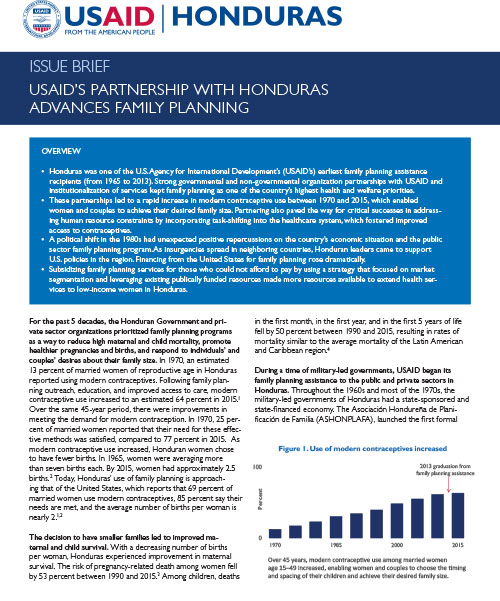Home » What We Do » Global Health » Family Planning » Resources » USAID's Partnership with Honduras Advances Family Planning
- What We Do
- Agriculture and Food Security
- Democracy, Human Rights and Governance
- Economic Growth and Trade
- Education
- Ending Extreme Poverty
- Environment and Global Climate Change
- Gender Equality and Women's Empowerment
- Global Health
- Water and Sanitation
- Working in Crises and Conflict
- U.S. Global Development Lab
For the past 5 decades, the Honduran Government and private sector organizations prioritized family planning programs as a way to reduce high maternal and child mortality, promote healthier pregnancies and births, and respond to individuals’ and couples’ desires to plan and space their children.
Overview
- Honduras was one of the U.S. Agency for International Development’s (USAID’s) earliest family planning assistance recipients (1965–2013). Strong governmental and non-governmental organization partnerships with USAID and institutionalization of services kept family planning as one of the country’s highest health and welfare priorities.
- These partnerships led to a rapid increase in modern contraceptive use between 1970 and 2015, which enabled women and couples to achieve their desired family size. Partnering also paved the way for critical successes in addressing human resource constraints by incorporating task-shifting into the healthcare system, which fostered improved access to contraceptives.
- A political shift in the 1980s had unexpected positive repercussions on the country’s economic situation and the public sector family planning program. As insurgencies spread in neighboring countries, Honduran leaders came to support U.S. policies in the region. Financing from the United States for family planning rose dramatically.
- Subsidizing family planning services for those who could not afford to pay by using a strategy that focused on market segmentation and leveraging existing publically funded resources made more resources available to extend health services to low-income women in Honduras.








Comment
Make a general inquiry or suggest an improvement.